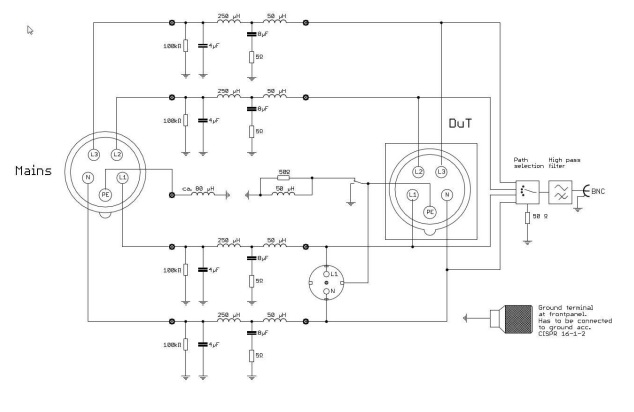Schwarzbeck NSLK 8128 Overview
The Schwarzbeck NSLK 8128 Line Impedance Stabilisation Network is equipped with a 250 µH choke as well as with a 50 µH choke which is connected in series for each path. The 250 µH choke provides an excellent decoupling between the power supply and the device under test starting at 9 kHz.

Instructions for use:
The purpose of a LISN is to provide the device under test with energy, to carry the interference voltage to the EMI measurement receiver and to load the RF emitted by the device under test with standardized impedance.
Important! Connect the LISN to protecting earth BEFORE applying any voltage to it! For this purpose you can use the screw terminal at the front panel and the aluminum brackets at the rear side of the device.
Due to high capacities very high leakage currents can occur (above 1 A). Thus it is not possible to use a residual current operated circuit breaker. It is recommended to use an isolating transformer.
The supply voltage has to be applied at the back panel of the LISN by using the CEE connector.
Important! When using the Schuko connector the operator has to make sure that the maximum current is limited to 16 A at the supply side. When using the 32A CEE connector the current has to be limited to 32 A at the supply side. There is no fuse built into this LISN to protect the device under test!
The device under test has to be connected to the Schuko socket or the CEE socket at the front panel. The maximum current that can be drawn is 32 A for each path when using the CEE connector and 16 A when using the Schuko socket. The maximum voltage that can be applied is 250 VAC or 400 VDC.
The input for the power supply is located at the back panel and provides a hard wired connection cable with a CEE plug.
The coaxial RF output has to be connected to the EMI measurement receiver using a BNC coaxial cable. You can choose the path that needs to be measured with the path selection switch. The path that is actually not measured will be terminated with 50 Ω automatically.
Protective earth switch
Using the switch labeled with “Safety ground” you can either put the protection earth of the Schuko socket straight to ground or in series with a parallel connection of a 50 µH choke and a 50 Ω resistor. Thus the protecting function of the protecting earth connector is ensured as long as the LISN is connected to earth properly.
A protective earth conductor that is decoupled RF-wise via the choke simulates the utilization of long cables. Since some interference suppression solutions are based on the protective ground conductor potential the emission of the device under test could vary depending on the switch setting.
“Artificial Hand”
If an "artificial hand" has to be connected to the equipment under test, a copper foil wrapped around the handle of the device under test has to be connected to the screw terminal labeled with “Hand Simulation”.
[split]
| Schwarzbeck NSLK 8128 Specifications | ||
| Topology: | V-LISN | |
| Frequency Range: | 9 kHz - 30 MHz | |
| Pre-filter choke: | 250 µH | |
| Impedance simulation: | 50 Ω || (50 µH + 5 Ω) | |
| Max. Current IEC 60309: |
4 x 32 A | |
| Max. Current CEE 7/4 socket: | 16 A | |
| max. Voltage: | 250 VAC 50/60 Hz 400 VDC |
|
| Supply cable: | hard-wired five-wire connection cable with CEE plug (IEC 60309) | |
| Connector for EuT: | CEE 7/4 Type F (Schuko) socket and IEC 60309 3L+N+PE 32 A CEE socket |
|
| Connector for "artificial hand": | 4 mm laboratory socket with screw terminal 6 mm, not removable |
|
| Connector to EMI-receiver: | BNC socked, 50 Ω | |
| Length: | 470 mm | |
| Width: | 450 mm | |
| Height: | 370 mm | |
| Weight: | 34.2 kg (38.5 kg RC) | |
| Standard: | CISPR 16-1-2 | |







